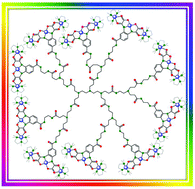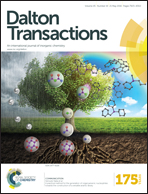CuII bis(oxamato) end-grafted poly(amidoamine) dendrimers†
Abstract
Successive treatment of the diethyl ester of 3,4-bis(oxamate)phenylene benzoic acid (3,4-bopbH2Et2OH; 1) with [Bu4N]OH and MCl2·nH2O (M = Cu, Ni; n = 2, 6) gave, upon extraction into CH2Cl2, binuclear complexes [Bu4N]4[{M(3,4-bopbO)}2CH2] (M-3, M = Cu, Ni) as novel symmetric methylene diesters. In contrast, subsequent addition of [Bu4N]OH and anhydrous NiCl2 to 1 afforded the very hygroscopic [Bu4N]3[Ni(3,4-bopbO)] (4) instead. In order to verify reaction conditions to achieve the corresponding carboxamides to 1 – as a crucial step for the synthesis of higher generation dendrimers – 1 was shown to react with RNH2 (R = Me (5a), Pr (5b)) to [RNH3][tdqc] (R = Me (6a), Pr (6b); tdqc = 1,2,3,4-tetrahydro-2,3-dioxo-6-quinoxaline carboxylate) by rearrangement reactions. Alternatively, if 1 was converted first to 3,4-bopbH2EtF (8) and treated next with PrNH2, the corresponding carboxamide 3,4-bopbH2Et2NPrH (7b) could be obtained in high yields. The reaction of 7b with [Bu4N]OH and MCl2·nH2O (M = Cu, Ni; n = 2, 6) gave conveniently mononuclear [Bu4N]2[M(3,4-bopbNPrH)] (M-9b, M = Cu, Ni). After thus optimizing reaction conditions, for the synthesis of higher-branched bis(oxamato) type complexes the (polyamido)amines 5c (enIIH2), 5d (denIIIH3), 5e (denVH5) and 5f (denXH10), possessing two, three, five or ten terminal amino groups, were reacted with appropriate equiv. of 8 to give the corresponding carboxamides enII(3,4-bopbH2Et2)2 (7c), denIII(3,4-bopbH2Et2)3 (7d), denV(3,4-bopbH2Et2)5 (7e) and denX(3,4-bopbH2Et2)10 (7f). Compounds 7c–f were converted to the corresponding CuII-containing complexes 9c–f, which were treated with the corresponding equiv. of [Cu(pmdta)][BF4]2 to afford 10c–f. Complexes of the series 9c–f and 10c–f possess two, three, five or ten end-grafted mononuclear {Cu(3,4-bopb)}2− and trinuclear {Cu3(3,4-bopb)(pmdta)2}2+ complex fragments, respectively. The identities of 7c–f were established by NMR spectroscopy and ESI-MS measurements. For 9c–f and 10c–f, ESI-MS, UV/Vis and ESR studies were applied to confirm the identities of these species. The magnetic properties of the {Cu3(3,4-bopb)(pmdta)2}2+ end-grafted poly(amidoamine) dendrimers 10c–f were studied by susceptibility measurements vs. temperature to give J values between −112 (10c) and −118 cm−1 (10d), which are typically observed for discrete trinuclear CuII-containing bis(oxamato) type complexes.


 Please wait while we load your content...
Please wait while we load your content...